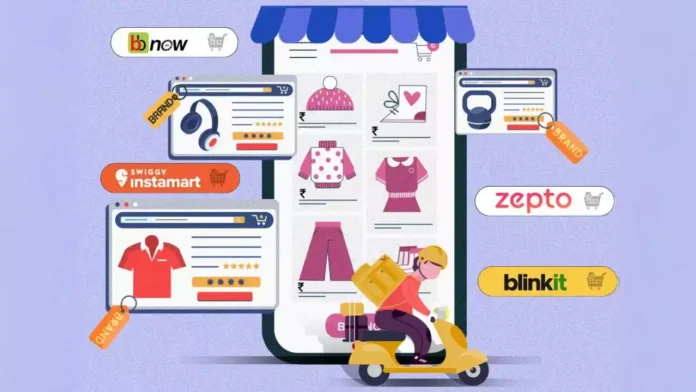Just two years ago, the idea of quick commerce or instant deliveries was often dismissed with laughter. Some even argued that consumers had no need for products to arrive in 10-15 minutes.
Today, quick commerce is rapidly gaining traction among many millennial and Gen Z households. Companies have extended their services beyond groceries, now delivering items ranging from fans and T-shirts to jewellery and iPhones.
In a recent report, Goldman Sachs highlighted that Blinkit‘s implied valuation, estimated at $13 billion, has surpassed that of parent company Zomato‘s core food delivery business, underscoring the swift expansion of this sector. While primarily concentrated in metro areas, quick commerce is gaining traction in cities like Vizag, Nagpur, Kochi, Jaipur, and Lucknow, according to executives at Swiggy Instamart and BigBasket.
Seshu Kumar Tirumala, chief buying & merchandising officer at BigBasket, stated that half of the new consumers that the company has acquired in the last year are all pure play rapid commerce clients. These customers frequently make spontaneous purchases and end up making 4–15 transactions each month from the platform.
Continue Exploring: BigBasket and Flipkart accelerate delivery services to compete with quick-commerce rivals
Swiggy, poised for an IPO, has witnessed Instamart’s growth in non-metro areas like Jaipur and Kochi more than double over the past year. “With a diverse range of products, we’re experiencing strong traction in both metros and non-metros,” stated Phani Kishan, CEO of Swiggy Instamart.
Continue Exploring: Swiggy merges Swiggy Mall with Instamart to expand quick commerce offerings beyond groceries
Analysts suggest that a portion of grocery spending in the top 7-8 cities might be shifting from local kirana stores to quick commerce platforms.
“Incremental purchases alone cannot justify the growth of quick commerce. Some parts of offline purchases and scheduled online deliveries have shifted to the segment. The platforms are also attracting sales from impulse purchases that would otherwise go to kirana stores,” explained Satish Meena, an advisor at market research firm Datum Intelligence.
Continue Exploring: Quick-commerce giants grab 30-50% of FMCG sales, kirana stores witness slowdown
As platforms such as Zepto, Swiggy Instamart, and Blinkit diversify into categories like beauty and personal care (BPC), toys, electronics, and stationery items, a portion of e-commerce sales is inevitably affected. Currently, non-grocery items constitute approximately 15%-20% of quick commerce purchases.
Continue Exploring: Quick commerce platforms Blinkit and Zepto expand into e-commerce, targeting fashion, beauty, electronics, and more
“If consumers can obtain a toy or a BPC item instantly through a quick commerce platform, they won’t wait for Amazon or Flipkart to deliver it,” explained Meena. “That’s why players like Flipkart are now venturing into the quick commerce model.”
“Consumers are ordering everything, from FASTags to air purifiers,” said Kishan.
As of FY24, Goldman Sachs approximates the gross order value (GOV) of the online grocery market to be around $11 billion. Within this, quick commerce already constitutes 50%, or $5 billion. Q-commerce platforms have also managed to offer products at a discount of about 10%-15% compared to local kirana stores, granting them a competitive advantage. “Given the scale of platforms such as Blinkit, they are able to secure pricing and sourcing advantages from manufacturers,” noted analysts at the firm.
“We aim to be an appealing choice even when compared to the top discount grocers in the offline market. If we can offer consumers better prices and 10-minute deliveries, why wouldn’t they choose Zepto?” remarked co-founder and CEO Aadit Palicha previously.
Quick commerce has the potential to represent 5%-6% of a household’s grocery expenditure in terms of wallet share.
Continue Exploring: D2C brands shell out 30-45% commission for quick-commerce platform listings





